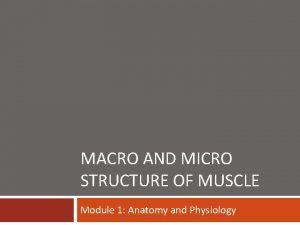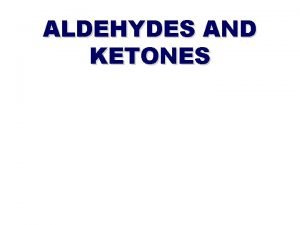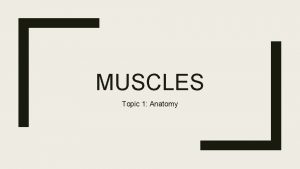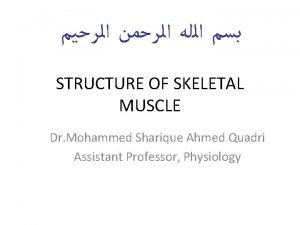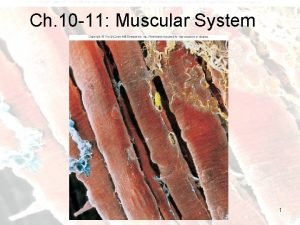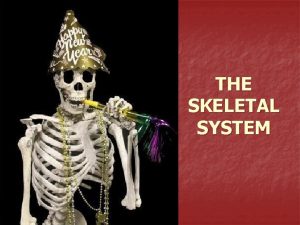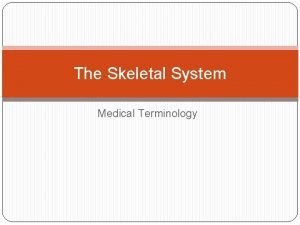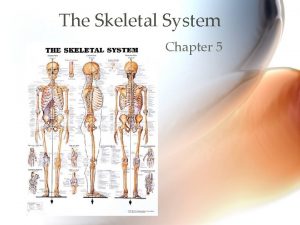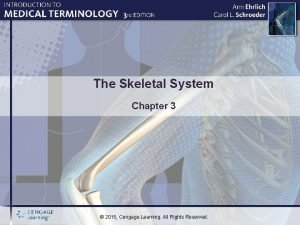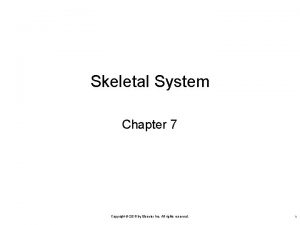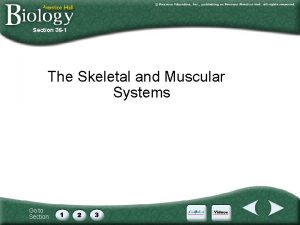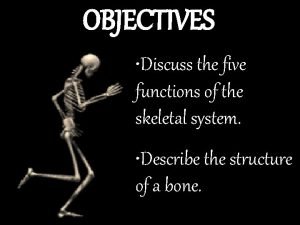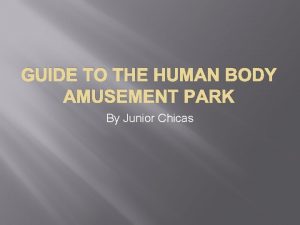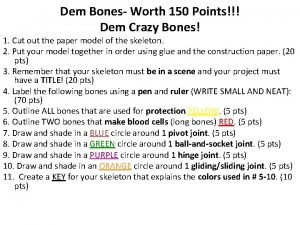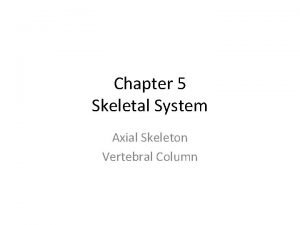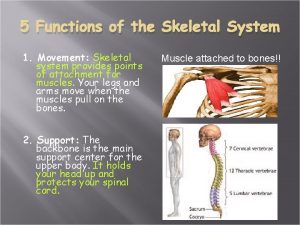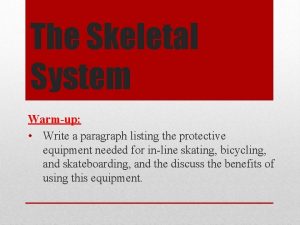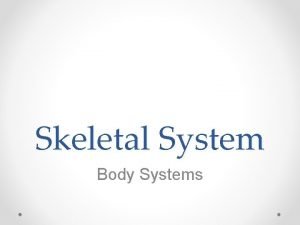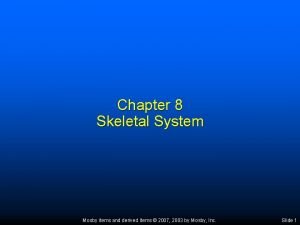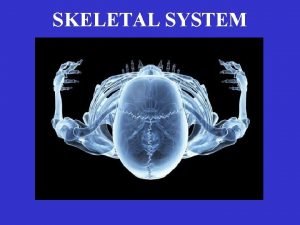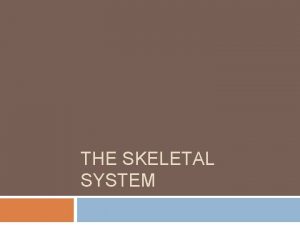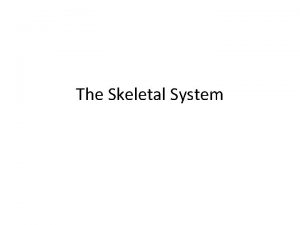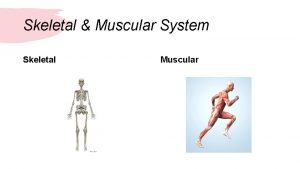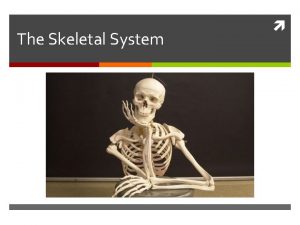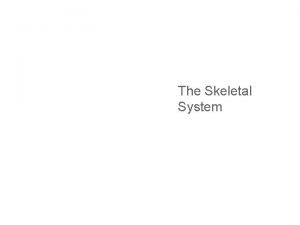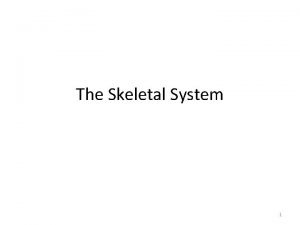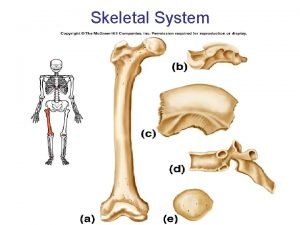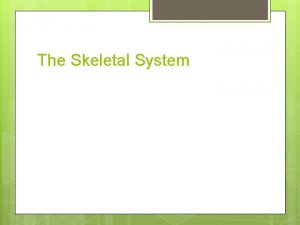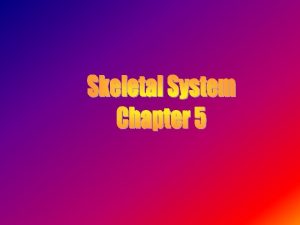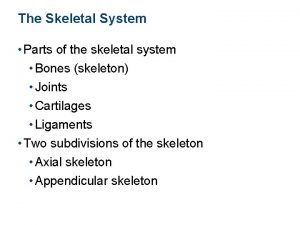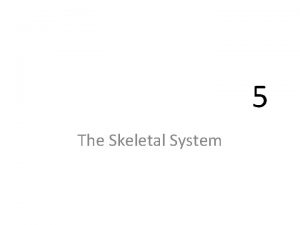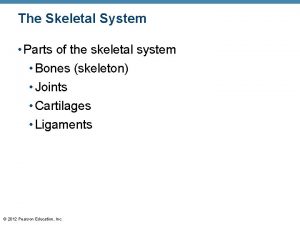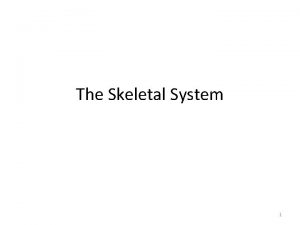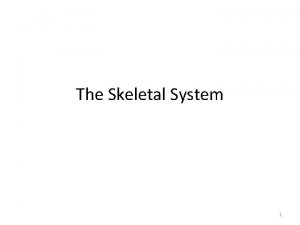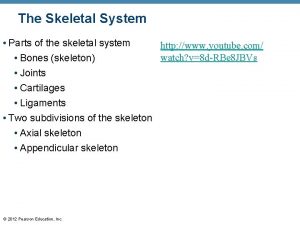The Skeletal System Structure The Skeletal System Parts


























- Slides: 26

The Skeletal System: Structure

The Skeletal System · Parts of the skeletal system · Bones (skeleton) · Joints · Cartilages · Ligaments (bone to bone)(tendon=bone to muscle) · Divided into two divisions · Axial skeleton- skull, spinal column · Appendicular skeleton – limbs and girdle Copyright © 2003 Pearson Education, Inc. publishing as Benjamin Cummings

Bones are classified by their shape: 1. Long- bones are longer than they are wide (arms, legs) 2. Short- usually square in shape, cube like (wrist, ankle) 3. Flat- flat , curved (skull, Sternum) 4. Irregular- odd shapes (vertebrae, pelvis)

Classification of Bones on the Basis of Shape Figure 5. 1 Copyright © 2003 Pearson Education, Inc. publishing as Benjamin Cummings

Axial skeleton supports and protects organs of head, neck and trunk Axial skeleton: skull (cranium and facial bones) hyoid bone (anchors tongue and muscles associated with swallowing) vertebral column (vertebrae and disks) bony thorax (ribs and sternum)

Appendicular skeleton includes bones of limbs and bones that anchor them to the axial skeleton Appendicular skeleton: pectoral girdle (clavicle, scapula) upper limbs (arms) pelvic girdle (sacrum, coccyx) lower limbs (legs) Articulation- where joints meet, connect, and are formed.



The Axial Skeleton · Forms the longitudinal part of the body · Divided into three parts · Skull · Vertebral Column · Rib Cage Copyright © 2003 Pearson Education, Inc. publishing as Benjamin Cummings Slide

The Axial Skeleton Figure 5. 6 Copyright © 2003 Pearson Education, Inc. publishing as Benjamin Cummings Slide

The Skull • 8 sutured bones in cranium • Facial bones: 13 sutured bones 1 mandible Cranium encases brain attachments for muscles sinuses


Bones of the Skull Figure 5. 11 Copyright © 2003 Pearson Education, Inc. publishing as Benjamin Cummings

Allows for growth

The Vertebral Column · Vertebrae separated by intervertebral discs made of cartilage · The spine has a normal S curvature · Each vertebrae is given a name according to its location Copyright © 2003 Pearson Education, Inc. publishing as Benjamin Cummings Figure 5. 14 Slide 5. 28


Thoracic cage ribs thoracic Vertebrae sternum costal cartilages • True ribs are directly attached to the sternum (first seven pairs) • Three false ribs are joined to the 7 th rib • Two pairs of floating ribs


Joints A joint, or articulation, is the place where two bones come together. • Fibrous- Immovable: connect bones, no movement. (skull and pelvis). • Cartilaginous- slightly movable, bones are attached by cartilage, a little movement (spine or ribs). • Synovial- freely movable, much more movement than cartilaginous joints. Cavities between bones are filled with synovial fluid. This fluid helps lubricate and protect the bones.

The Synovial Joint Figure 5. 28 Copyright © 2003 Pearson Education, Inc. publishing as Benjamin Cummings Slide 5. 51

Types of Synovial Joints Based on Shape Figure 5. 29 a–c Copyright © 2003 Pearson Education, Inc. publishing as Benjamin Cummings Slide

Types of Synovial Joints Based on Shape Figure 5. 29 d–f Copyright © 2003 Pearson Education, Inc. publishing as Benjamin Cummings Slide

Types of Joints Hinge- A hinge joint allows extension and retraction of an appendage. (Elbow, Knee)

Ball and Socket- A ball and socket joint allows for radial movement in almost any direction. They are found in the hips and shoulders. (Hip, Shoulder)

Gliding- In a gliding or plane joint bones slide past each other. Mid-carpal and midtarsal joints are gliding joints. (Hands, Feet)

Saddle- This type of joint occurs when the touching surfaces of two bones have both concave and convex regions with the shapes of the two bones complementing one other and allowing a wide range of movement. (Thumb)
 Skeleton
Skeleton Micro and macro structure of skeletal muscle
Micro and macro structure of skeletal muscle Aldehydes and ketones
Aldehydes and ketones Structure of skeletal muscle
Structure of skeletal muscle Mohammed sharique
Mohammed sharique Skeletal muscle tissue structure
Skeletal muscle tissue structure 5 main functions of the skeleton
5 main functions of the skeleton Medical terminology skeletal system
Medical terminology skeletal system Skeletal system
Skeletal system The skeletal system chapter 3
The skeletal system chapter 3 Chapter 7:4 skeletal system label the skeleton
Chapter 7:4 skeletal system label the skeleton Chapter 5 the skeletal system figure 5-13
Chapter 5 the skeletal system figure 5-13 Section 36-1 the skeletal system
Section 36-1 the skeletal system Five functions of the skeletal system
Five functions of the skeletal system Body amusement park
Body amusement park Are crazy bones worth anything
Are crazy bones worth anything Chapter 6 the skeletal system answer key
Chapter 6 the skeletal system answer key 7 12 5 spine
7 12 5 spine Chapter 32 section 2 the skeletal system answer key
Chapter 32 section 2 the skeletal system answer key Body system amusement park
Body system amusement park Skeletal system points
Skeletal system points Navigating the body skeletal system #1
Navigating the body skeletal system #1 Skeletal system paragraph
Skeletal system paragraph What are the five functions of the skeletal system
What are the five functions of the skeletal system Whats the main function of the skeletal system
Whats the main function of the skeletal system Chapter 8 skeletal system
Chapter 8 skeletal system Chapter 7:4 skeletal system
Chapter 7:4 skeletal system

